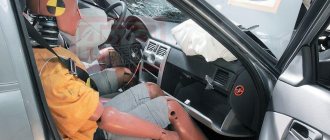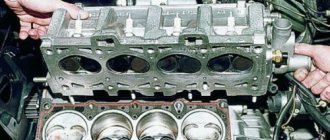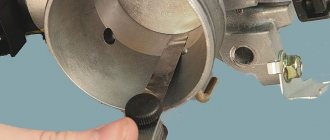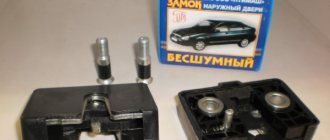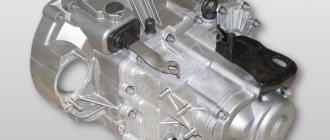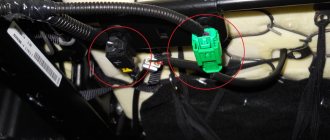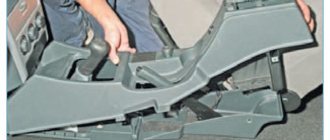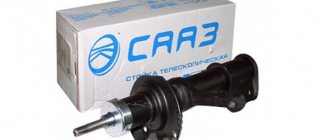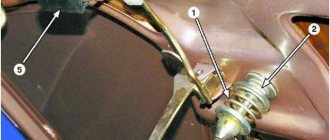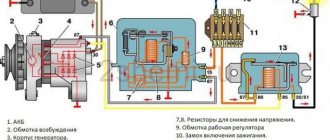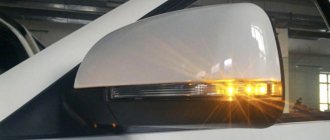The abs sensor of a Priora car is placed near the wheels. It comes in front and back. The ABS unit is placed near the engine on the right, if you open the hood and stand in front of the car. When AbS (ABC) lights up on the panel, it means there is a problem with the system. Why do cars need this system?
Abs affects the braking of the car, Priora with this system brakes 2 times faster than without it. The wheels brake in small portions, measured by a computer. Initially in 2008 there were cars without it. Read the article to the end and find out what the error is, what it is responsible for and why the ABS lights up and does not work. Priora has sensors and an ABS unit. Failure of any spare part leads to problems. On the Prior, there are 18 errors belonging to the braking system.
The appearance of an icon on the dashboard indicates an error occurring in the operation of the vehicle. There are serious errors on the Priora, if they occur, you should not tempt fate and move on, but there are errors that can be postponed. For example, the ABS system is considered very valuable for a modern driver in a car.
The Priora's ABS system saves you during unexpected and sudden braking and makes the process itself more efficient, reducing the braking distance. Therefore, when the ABS light is on on the Priora’s dashboard, strange feelings of uncertainty arise - knowing that the road situation can be so unpredictable that you will have to brake sharply, you involuntarily have to look for the reason why the icon appeared on the dashboard.
As in many systems, this behavior of the car's control unit may result in the ABS sensor on the Priora having to be replaced. A large system with a fairly simple device is worth checking - for your own safety.
Methods for checking the ABS sensor
ABS sensors play an important role in the operation of the car's braking system - the braking efficiency and uninterrupted operation of the unit as a whole depend on them. The sensor elements send data about the degree of rotation of the wheels to the control unit, and it analyzes the incoming information, building the desired algorithm of actions. But what to do if you have doubts about the serviceability of the devices?
Replacing the ABS block
For repair you need to prepare:
- key "13";
- ratchet;
- head "10".
The procedure for working with Priora is as follows:
- Stop the car and raise it. Disconnect the minus from the battery.
- Drain the brake fluid from the cylinder brake hose.
- Unscrew the brake pipes connected to the block. There are 6 of them in total.
- Unhook the power lock and disconnect the wires.
- Unscrew the nuts fastening to the car body.
- Slowly pull the block and remove it.
- Install the unit by connecting everything in reverse order. Don't forget to bleed the brake system.
Symptoms of a device malfunction
The fact that the ABS sensor is faulty will be indicated by an indicator on the instrument panel - it lights up when the system is deactivated, which turns off even if there is the slightest problem.
Evidence that ABS has ceased to “interfere” with the operation of the brakes:
- Wheels constantly lock during heavy braking.
- There is no characteristic knocking noise with simultaneous vibration when pressing the brake pedal.
- The speedometer needle is delayed relative to acceleration or does not move from its original position at all.
- If two (or more) sensors on the dashboard are faulty, the parking brake indicator also lights up and does not go out.
The ABS indicator on the dashboard indicates a system malfunction
What to do if the ABS warning lamp on the car’s dashboard does not behave quite correctly? You should not immediately change the sensor; first, the devices should be checked - this procedure can be performed independently, without resorting to the services of highly paid craftsmen.
Why does the indicator on the instrument panel light up?
If the ABS light comes on on the dashboard, the reasons for this may be the following:
- It lights up every time the car engine starts - this is how the system signals that it is in working condition. If the system is fully operational, the light should go out after some time. If the ABS light does not light up when you start the engine, the indicator is most likely faulty.
- If the light does not go out for a long time, this means that there are problems in the ABS system. The on-board computer, detecting errors, generates a failure code, saves it and turns on the warning indicator.
Ways to check functionality
To determine the condition of a part, we will perform a series of steps to diagnose it, moving from simple to complex:
- Let's check the fuses by opening the unit (inside the passenger compartment or in the engine compartment) and inspecting the corresponding elements (indicated in the repair/operation instructions). If a burnt component is found, we will replace it with a new one.
- Let's inspect and check:
- integrity of connectors;
- wiring for abrasions that increase the risk of a short circuit;
- contamination of the part, possible external mechanical damage;
- fixation and connection to ground of the sensor itself.
If the listed measures do not help to identify a device malfunction, it will have to be checked using instruments - a tester (multimeter) or an oscilloscope.
Tester (multimeter)
This method of diagnosing the sensor will require a tester (multimeter), instructions for operating and repairing the car, as well as PIN - wiring with special connectors.
The device combines the functions of an ohmmeter, ammeter and voltmeter
Tester (multimeter) is a device for measuring electric current parameters, combining the functions of a voltmeter, ammeter and ohmmeter. There are analog and digital device models.
To obtain complete information about the performance of the ABS sensor, you need to measure the resistance in the device circuit:
- We lift the car with a jack or hang it on a lift.
- Remove the wheel if it prevents access to the device.
- Remove the cover of the system control unit and disconnect the controller connectors.
- We connect the PIN to the multimeter and the contact socket of the sensor (the connectors for the rear wheel sensors are located inside the cabin, under the seats).
We connect the PIN to the tester and the contact socket of the sensor
The device readings must correspond to the data specified in the repair and operation manual for a particular vehicle. If the device resistance:
- below the minimum threshold - the sensor is faulty;
- approaches zero - short circuit;
- unstable (jumping) at the moment of twitching of the wire - a violation of contact inside the wiring;
- infinity or no readings - wire break.
Attention! The resistance of the ABS sensors on the front and rear axles is different. The operating parameters of the devices are 1–1.3 kOhm in the first case and 1.8–2.3 kOhm in the second.
Video “Diagnostics of the ABS sensor”
How to check using an oscilloscope (with connection diagram)
In addition to self-diagnosis of the sensor with a tester (multimeter), it can be checked using a more complex device - an oscilloscope.
The device examines the amplitude and time parameters of the sensor signal
An oscilloscope is a device that studies the amplitude and time parameters of a signal, which is intended for accurate diagnosis of pulse processes in electronic circuits. This device detects problems with connectors, broken connections to ground, and broken conductors. The test is performed by visually observing the vibrations on the device display.
To diagnose the ABS sensor with an oscilloscope, you must:
- Fully charge the battery so that during the measurement you can observe voltage drops (jumps) on the connectors or conductors.
- Find the touch sensor and disconnect the upper connector of the part.
- Connect an oscilloscope to the contact socket.
Connecting the device to the ABS sensor connector (1 - toothed disc-rotor; 2 - sensor)
The serviceability of the ABS sensor is indicated by:
- equal amplitude of signal fluctuations when the wheels of one axle rotate;
- absence of amplitude beats when diagnosing with a sinusoid signal of lower frequency;
- maintaining a stable, even amplitude of signal fluctuations not exceeding 0.5 V when the wheel rotates at a frequency of 2 rps.
Note that an oscilloscope is a rather complex and expensive device. Modern computer technologies make it possible to replace this device with a special program downloaded from the Internet and installed on a regular laptop.
Video “Laptop instead of an oscilloscope”
Checking a part without instruments
The easiest way to diagnose a device without instruments is to check the magnetic valve on the induction sensor. Any metal product (screwdriver, wrench) is applied to the part inside which the magnet is installed. If the sensor does not attract it, it is faulty.
Most anti-lock brake systems of modern cars have a self-diagnosis function with errors displayed (in alphanumeric encoding) on the on-board computer screen. You can decipher these symbols using the Internet or the machine’s operating instructions.
How to repair wiring
We treat it with a special means for cleaning electrical contacts (for example, graphite grease) and clean the contacts from oxides. We clean the wheel speed sensor and the surface around the sensor from dirt.
Attention! Keep ABS sensors away from magnets as this may cause damage.
What to do if a breakdown is detected
What to do with the ABS sensor if a malfunction is detected? If the problem point is the device itself, it will have to be replaced, but in the case of electrical wiring, you can fix the defect yourself. To restore its integrity, we use the “soldering” method, carefully wrapping the joints with insulating tape.
If the ABS indicator on the dashboard lights up, this is a clear sign of a sensor failure. The described steps will help identify the cause of the breakdown, but if you lack knowledge and experience, it is better to contact a car service center. Otherwise, illiterate diagnostics of the condition, coupled with improper repair of the device, will reduce the effectiveness of the anti-lock braking system and can provoke an accident.
Differences between ABS brakes
The main difficulty lies in ignorance of the nuances of operation and the main differences from the same procedure on conventional brakes.
Bleeding brakes with ABS has three main differences from conventional ones:
- the pipeline system in the presence of ABS is under increased pressure;
- During the procedure, constant monitoring of the brake fluid level will be required;
- the pump runs for no more than 10 minutes.
If you do not control the brake fluid level in the system, it will reach a critical minimum and the drive pump will begin to pump air.
If the pump runs longer than the set 10 minutes, turn off the ignition and allow the unit to cool for 10-15 minutes.
Checking the ABS sensor yourself. How to check the ABS sensor in different ways?
Even children probably know what ABS ( Anti-lock Braking System This system allows you to perform the most effective braking to stop the vehicle as quickly as possible. The system is electronic and is equipped with many sensors and a control unit, which ensures that the wheels do not lock during braking, that is, “do not skid.” Such an invention saves hundreds or maybe even thousands of lives on the road every day. The ABS system prevents skidding and loss of control, which is very important on slippery roads, as well as in case of emergency braking.
In this article, I will tell you how to check the ABS sensor if it malfunctions, as well as if an emergency indicator appears on the dashboard in the form of three English letters “ABS”. You will learn how to test the ABS sensor at home in various ways using a multimeter.
The most common breakdown in the ABS system is a circuit break, when communication is lost between the control unit and the sensor. This can happen for various reasons, which you will learn about a little later.
How to modify the design
To protect the wiring harness from the environment, you can use a D-shaped seal. We lay the wires in it and wrap it with electrical tape. We put everything in the corrugation. We glue the cover covering the ABS sensor connector around the perimeter with the same sealant. This will prevent moisture and dirt from entering the area where the sensor and connector are located.
Attention! If the ABS fails, the brakes remain operational, but the braking efficiency is reduced, which is especially dangerous on some surfaces. See why.
How to recognize a faulty ABS system or ABS sensor?
- As I already said, the corresponding indicator lights up on the panel; this can happen while driving, braking, or when turning the key in the ignition. In the latter case, the appearance of the inscription indicates self-diagnosis of the system; after you start the engine, the light should go out.
- If the ABS system malfunctions during braking, you will not hear the characteristic sound of the ABS unit located under the hood and will not feel the vibration that occurs when you sharply press the brake pedal and try to slip the wheels.
Why does the ABS light even come on?
In a normally running vehicle, this indicator shows you that the wheels have been unlocked. In this case, everything works fine, the sensors sensed the need to turn on the safety system, initiated its operation and demonstrated to the driver that some assistance was provided when braking. When you see the ABS light on while braking, it is better to release the brake pedal a little and take over control of the car. If you have an expensive, high-tech car, you can trust the well-thought-out systems and let ABS+EBD do the job. In other cases, the light may be on for the following reasons:
- the sensors are clogged, the on-board computer indicates that the diagnostic error code should be read;
- Dirt or rust got on the sensors, which caused the anti-lock braking system to turn on incorrectly;
- there is a problem in the on-board electrical system, which is demonstrated by random lights coming on;
- the wheel bearing has failed, which forces the sensors to constantly turn on the anti-lock braking system by mistake;
- the fuses in the unit responsible for the ABS system have failed and are passing the signal directly;
- There was an error in the computer that caused the ABS light to come on.
Also, sometimes troubles occur with the generator and other elements of the machine’s electrical circuit, which can result in the lighting of the diagnostic system light or warning lights of any type. For example, on a Volkswagen car produced in the 2000s, the anti-lock braking system light comes on even if there is an error in completely different components. Therefore, self-diagnosis is only a partially acceptable method of solving the problem, because often the driver does not have special tools at hand for a good investigation.
- there is no contact in the connection connector;
- break in the wire to the sensor (check the wires);
- The ABS sensor is faulty (check and, if necessary, replace the ABS sensor);
- the crown of the hub has become unusable;
- The ABS system control unit is faulty.
If you look at the instrument panel and see that the ABS icon does not go out and is constantly on, then the first thing you need to do is check the fuse for this system. If the fuse is working, then inspect the sensors on the wheels.
The reason for the sensors on the wheels not working may be oxidation of the sensor connector on the hub (this often happens in areas where roads are treated with various chemicals and reagents) or the presence of dirt on the connectors.
It also happens that the ABS sensor connection wires fray, which is why there is no full contact or the contact works intermittently.
It also happens that you recently changed the brake pads or the hub and simply forgot to connect the ABS sensor connector plug.
If there is a working ABS system during heavy braking, when the wheels are stopped by the braking system, and the car continues to drive, the ABS system is activated and releases the wheels, then locks again, then releases again, then locks again, as long as you hold the brake pedal pressed and the car will continue to move.
In cars without ABS, if you press the brake and the car continues to move due to a slippery road surface, then you need to brake jerkily: press all the way and release, press and release, in this case control of the vehicle is maintained and the braking distance is reduced. I experienced this myself when I had a car of the VAZ 2106 family. When I was driving it in the evening in rainy weather, there were cars standing in front of the traffic lights at the traffic light, I drove up from behind and pressed the brake, the “six” continued to move due to a coating of dirt on the asphalt, I had to press the brake all the way several times, so to speak, to use myself instead of ABS. The car stopped safely.
When driving a car with ABS, you must press the brake pedal all the way for the anti-slip system to work. Do not use the intermittent braking method, as on a car without ABS.
Also, sometimes the ABS light comes on when the wheels slip. But this is not critical. You just need to apply hard braking a few times and the ABS light will go out.
If, suddenly, after all the checks (wires, sensors, cleanliness of contacts, hub crown, control unit) the ABS light is still on, then you will have to carry out computer diagnostics at a service center or, if you have a scanner, with your own hands. The brake system may be air-filled; in this case, it is necessary to properly bleed the ABS brakes.
What to do first?
It is necessary to check the ABS sensors located near each wheel hub. Your task is to detect a violation in the connection of the sensors, a broken wire or damage to the ABS sensor housing. In any of these cases, you will one way or another see the corresponding indicator on the panel, well, provided that the system control unit itself is working and not “buggy”.
Checking the ABS sensor - measuring the resistance
- We jack up the wheel on which you think the inoperative or faulty sensor is located, or each wheel in turn if you don’t know exactly which sensor is faulty.
- Next, remove the wheel and gain access to the sensor.
- Remove the housing, as well as the protective control unit and connectors that supply power to the sensors.
- After that, we insert wires into the circuit of wires with PIN connectors and connect them with the sensor and multimeter.
- We measure the resistance and compare it with the one that should be by default (you can find it in the manual) or with a representative of the manufacturer of your car.
- We check the wiring for breaks or short circuits.
- Rotate the wheel while watching the multimeter readings, the resistance should change.
- Device - leg - 5-26 Ohm.
- Device - "ground" - from 20 kOhm or more.
For more details on how to check the ABS sensor, watch this video:
Checking the ABS sensor using a tester - measuring the voltage
- Let's jack up the wheel.
- Turn on the multimeter, set the DC voltage measurement mode.
- We connect the electrodes of the device to the connectors and check the readings, while rotating the wheel (about 1 rpm).
- A working ABS sensor will show voltage on the device
0.25-1.2 Volts. If the wheel rotation speed is higher, the readings will increase accordingly.
How to check a sensor with an oscilloscope?
To diagnose the serviceability or malfunction of the ABS sensor, you can even use an oscilloscope or, more simply, a tester. When connected, a graph will be displayed on the device; using amplitude analysis, you can judge the serviceability or malfunction of the sensor.
The problem is that this device is not available at every service station, not to mention the garage in which you are going to conduct all your “experiments”. The device is expensive and quite difficult to understand, so to work with it you need to have certain knowledge and skills.
In modern cars, the ABS system has a self-diagnosis function; using special software, you can read the error code and then decipher it using a special table.
What brake fluid should I use?
The system responsible for braking the Priora can contain up to one liter of working reagent. The brake fluid should be clear with some yellowish tint. When the color of the liquid changes to dark, topping up is impossible. In this case, the substance must be replaced.
It must be said that the brake fluid in the Lada Priora system is replaced approximately every three years. This time period is considered the most optimal, since during this time the liquid will change under the influence of temperature heating. Brake fluid includes: main components up to 98% and additives. Depending on the content of the base, TJ is classified into three types:
| Type of working fluid | Compound |
| Mineral | Contains alcohol and castor oil. |
| Glycolic | Contains polyglycols and their esters. |
| Silicone | Includes organosilicon polymer products. |
In addition to these compositions, brake fluid is divided according to the degree of thickening and the temperature at which it can boil.
The Lada Priora uses DOT-4 brake fluid based on glycol. Its volume must be at least one liter. If the working fluid needs to be replaced along with the flushing procedure, then it will require more fluid - about one and a half liters.
To correctly decide which brake fluid to use, you need to carefully study whether the fluid meets the necessary requirements and GOST standards. The main ones include:
- The temperature at which heating occurs to boiling.
- Volume of least corrosive activity;
- Possibilities for lubrication.
- Stable viscosity.
On the labels issued by manufacturers, everything is described colorfully and attractively, but this is not always true. After analyzing consumer reviews and practical experience, the following conclusions were made.
Foreign liquids that received positive ratings include: Castrol React DOT-4, Motul DOT 5.1, Liqui Moly Bremsenflussigkeit DOT-4.
Russian-made brake fluids that can be used include: Ros DOT-4 and Sintec Super DOT-4.
Other brands may be considered questionable and may cause harm to the car owner and other road users.
Before deciding on the brand of brake fluid for Lada Priora, you need to understand the specifications that are established for this car. Thus, the Priora brake system must be filled with glycol fuel fluid (FMVSS 116 not lower than DOT-3).
Is it possible to repair the ABS sensor?
The question of whether it is possible to repair this sensor is difficult to answer unequivocally; it increasingly depends on the degree of its damage and malfunction. If it’s all about simple damage to the wiring, then solving the problem will not be difficult. If the damage is more global, the core or winding is damaged, then most likely repairing such a sensor will simply not be possible and will require a complete replacement. Despite the fact that 99% of experts recommend replacing the sensor if it malfunctions or has problems with the winding, there are those who successfully restore these sensors at home using improvised means. You can find out more about this repair in the video below.
This video clearly demonstrates how to repair an ABS sensor at home.
That's all for me. Thank you for your attention, I hope you found it interesting and were able to learn something new for yourself. I look forward to your comments on this topic, perhaps you have encountered such a problem or managed to solve it. Until next time, bye.
When to change pads
The frequency of replacing rear pads is 2 times less than the front ones. Since they have less load when braking.
On average, the mileage they can cover without replacement is 60-90 thousand km. Of course, these figures are approximate, since the operating conditions and driving style of each driver are individual. There are cases where the pads can be worn out by 30,000 km.
It is necessary to change the pads if:
- The thickness of the lining is less than 1.5mm. With such a thickness, the block no longer performs its functions and is simply not able to effectively brake the car.
- The overlay begins to peel off from the base. Using a pad with such problems is unacceptable. The pad can come off and get caught in the rotating parts, causing the wheel to wedge.
Lining Thickness
There is no need to remove the drum to check the thickness of the lining. You just need to remove the special rubber plug behind the drum and assess its condition.
Plug for checking the condition of the rear pads
How to check the ABS sensor for functionality?
The task of the anti-lock braking system (ABS), installed on the vast majority of modern cars, is to prevent the car from skidding during heavy braking. To do this, a special device is built into each hub, transmitting information about wheel rotation to the electronic control unit. Since a malfunction of this element is often the cause of system failure, the car owner should know how to check the ABS sensor in a garage.
Design and purpose of components
The anti-lock braking system consists of three main components:
- Wheel speed sensors
- Control unit (module)
- Actuator
Car ABS elements
As noted, this system is often used as a basis for others. At the same time, the components of a number of other systems are only an addition to the ABS.
Sensors
Speed sensors are very important components, since the operation of the ABS system is based on their readings. Based on the pulses they supply, the control module calculates the rotation speed of each wheel, and based on the calculations, the actuator is controlled.
Location of the speed sensor on the wheel hub
The ABS design uses two types of sensors. The first ones are called passive sensors. These elements are of the inductive type.
Their design includes the sensor itself, consisting of a winding, a core and a magnet, as well as a gear ring used as a driving element. The ring gear is mounted on the hub, so it rotates with the wheel.
Inductive type sensor
The essence of the functioning of the passive element is very simple - the winding generates a magnetic field through which the gear ring passes. The existing teeth, when passing through the field, influence it, which ensures the excitation of voltage in the sensor. The alternation of teeth with cavities ensures the creation of voltage pulses, which make it possible to calculate the speed of rotation of the wheel.
A negative quality of passive sensors is the lack of measurement accuracy when driving at low speeds, which can cause the ABS system to not work correctly.
Now, due to the existing drawback, passive sensors are not used in the anti-lock braking system and have been replaced by so-called active elements.
As in the first option, active sensors consist of two main components - the sensor itself and the setting element. But in active elements, sensors are built either on the magnetoresistive effect or on the Hall effect. Both options require power supply to operate (the passive elements generated it themselves).
As for the driving element, the design uses a ring with magnetized sectors (multipole).
Design and principle of operation of an active speed sensor
The essence of the work of active elements is different. In the magnetoresistive version, a constantly changing field (from the master ring) leads to changes in the resistance readings in the sensor. In a Hall element, this field changes the voltage itself. In both cases, an impulse is created, from which the rotation speed can be calculated.
Active type elements have become widespread due to their high measurement accuracy at any speed.
Control block
The ABS system control module, like other ECUs involved in car systems, is needed to receive and process impulses transmitted from wheel sensors. It contains tabular data on the basis of which it controls the actuator. That is, after receiving a signal from each sensor, it compares it with the information entered in the table, and based on the results obtained, it will determine what it should do.
In a car with a number of systems based on ABS, the control unit has additional modules responsible for the operation of its systems.
Actuating mechanism
The actuator (also called a hydraulic unit or ABS module) is the most complex in design and consists of a number of elements:
- solenoid valves (inlet, outlet);
- pressure accumulators;
- return pump;
- shock-absorbing chamber.
ABS unit design
In the classic scheme, only one line goes to the brake operating mechanism, through which fluid is supplied from the master cylinder. In ABS, the return line is embedded into it, but it only passes inside the module.
The inlet valve is the only element installed on the main supply line. Its task is to shut off the liquid supply under certain conditions; by default it is open.
Briefly about the principle of operation
The ABS function simulates the harsh, repeated pressure on the brake pedal experienced by drivers of older cars on slippery roads. Electronics uses this method of braking much more efficiently, locking and “releasing” the wheels several times per second. The operating algorithm is as follows:
- During sudden braking, the control unit monitors the behavior of the wheels using sensors.
- If one or more wheels stop rotating, the ECU issues a command to a hydraulic valve that releases fluid from that circuit. The pads stop holding the disc and rotation resumes.
- By comparing the readings of all meters, the controller makes sure that braking is not complete and closes the hydraulic valve, and the wheel is blocked again. The cycle, lasting a fraction of a second, is repeated until the machine stops completely.
Important! If the functionality of one or more sensors is impaired, the ABS will fail entirely, since the electronic unit will not be able to compare the behavior of the wheels.
The latest generation ABS sensor is a coil with a semiconductor element installed in a stationary part of the hub. In the immediate vicinity of it, a toothed ring is attached to the brake disc, whose rotation is monitored by a sensor. It happens like this: the controller supplies voltage to the device, and it constantly changes the resistance due to the passage of a series of teeth on a rotating ring.
When the amount of electrical resistance becomes constant, the ECU regards this fact as wheel locking and turns on the above-described algorithm. If the element fails, the ABS system is completely disabled.
Signs of sensor malfunction
The following symptoms indicate that the ABS sensor needs to be checked:
- when braking sharply or on a slippery road, the car moves “skid” and goes into a skid;
- there is no characteristic sound of ABS activation - frequent tapping or crackling from the side of a locked wheel (the type of noise depends on the make of the car);
- The anti-lock braking system warning light on the dashboard lights up.
If, for various reasons, the functionality of several sensors is disrupted, then the indicator for turning on the handbrake or a malfunction of the brake system additionally flashes on the instrument panel. You can continue to operate the car, but in slippery areas or during an emergency stop, the driver will have to work instead of ABS - often and sharply press the pedal.
Checking the quality of work performed
After replacing the sensor, its functionality is checked. To do this, it is enough to accelerate to a speed of 40 km/h on a flat, safe section of the road and perform sharp braking. If the car stops without pulling to the side, vibration is transmitted to the pedal and a specific sound of brake pads being activated is heard - the ABS system is operating normally.
Today you can easily find and buy any ABS sensors - from expensive original devices to analog parts at an affordable price. Remember that proper selection of system elements plays an important role in its uninterrupted operation. When choosing a sensor, study the manufacturer's instructions and make sure that it fits the car, and this review will help you replace the device yourself.
How is the check performed?
Since the operation of a working ABS sensor is based on changes in electrical resistance when the wheel rotates, its parameters can be measured with a multimeter or a tester operating in ohmmeter mode. Conditions for diagnostics: a regular garage or a flat area, an inspection ditch is not required. From the tools, take a jack and a wheel wrench.
To check the ABS sensor with a tester, follow these steps:
- Place the car on a level surface and secure it with wheel chocks. The handbrake should not be applied.
- Jack up the rear wheel and remove it. Having found the wiring harness going to the sensor in the hub, find the connector and disconnect it. Clean all contacts thoroughly, preferably with a special liquid.
- Turn on the multimeter to measure resistance and take measurements in the block coming from the sensor. Depending on the brand of car, the value should be from 500 Ohm to 1.4 kOhm.
- Grab the drum or disc with your hand and spin it while watching the tester readings. The resistance must change.
- Switch the device to voltage measurement mode and turn on the ignition. Check the presence of DC current from the control unit by connecting a multimeter to the second part of the connector.
- Repeat the operation on all wheels.
On different car models, the connector may be located in different places - hidden under the bottom or plastic protection. To locate the block, probe the wiring harness by hand.
ABC control unit on Priora
Structurally, on the Priora, the ABS ECU is mounted together with the EWH and valves that regulate the pressure into a single unit - the hydraulic unit.
It is located on the front left side member of the vehicle. The hydraulic unit is connected to the entire system by a common wiring harness. It includes pipes for supplying brake fluid to the working cylinders. An EWH is also installed here, increasing the pressure in the system. This unit does not understand handicraft conditions. Usually replaced entirely with a new one.
Analysis of diagnostic results
The problem with the ABS function does not always lie in the sensors. The culprits of system failure may also be the wires connecting the elements to the control unit. That is why it is necessary to carry out 3 measurements and draw the following conclusions based on the results:
- If the resistance of the ABS sensor tends to zero or, conversely, the device shows an infinity symbol, then there is a malfunction of the element itself. Another option is a violation of the insulation or a break in the section of conductors from the connector to the sensor.
- The tester shows that the resistance is within normal limits, but when the brake disc rotates, its value remains constant. There are two versions here: severe contamination of the gear ring (as an option - destruction) and, again, failure of the sensor.
- The absence of voltage in the supply line indicates a break in the electrical circuit coming from the controller.
In the first case, it is necessary to remove the device from the hub and inspect the wires for fractures, breaks or short circuits. To be sure, measure the resistance again, while moving the conductors. If the result is negative, buy and install a new part.
If the resistance remains the same, get to the gear ring, clean it thoroughly and inspect it. If you find mechanical damage, it is better to replace the spare part.
Advice. Sometimes unscrupulous or ignorant auto mechanics damage the ring when repairing the suspension, or even throw it away completely. When picking up your car from a mechanic, always check that this important part is present.
In the case when there is no voltage in the controller circuit, you should ring this section of the wiring. How to do it:
- Find out where the electronic control unit for the hydraulic valves is located. For example, in a Chevrolet Aveo it is located behind the brake fluid reservoir, and in a Renault Megane it is located on the side of the alternator drive belt.
- Remove the block from the ECU and clean the contacts. Find the pinout of the wires or track them by color.
- Place a shorting jumper on the block located near the wheel. Test the circuit with an ohmmeter or a regular light bulb with a battery.
The easiest way to find the ECU if there is no documentation for the car is to follow the brake pipes leading to the hydraulic unit.
The latter stands next to the controller or is connected to it by a bundle of wires. If an open circuit is detected, you will have to look for the defect along the entire line in order to eliminate it. The work is quite complex, so it should be entrusted to an experienced auto electrician.
Why pneumatic
Communities Lada Priora Lada Priora Club Blog Ignition switch wires
Braking requires quite a lot of effort from the driver. Making such an “injection” and bleeding the brakes on four wheels at once is not an easy task. Therefore, a solution was found: due to the vacuum in the intake system, a special mechanism, a vacuum, greatly facilitates this process. And the pedal is quite easy to press.
Important! It is the system, operating on the “syringe” principle, with many rubber seals, that requires the complete absence of air in the system, since its presence reduces the efficiency of the brakes to zero. Simply put, due to the difference in the density of air and brake fluid, instead of uniform pressure on the piston of the working cylinder, you will get a chaotic movement of air bubbles inside the system
Because of this, they sometimes need to be pumped
Simply put, due to the difference in the density of air and brake fluid, instead of uniform pressure on the piston of the working cylinder, there will be a chaotic movement of air bubbles inside the system. Because of this, they sometimes need to be pumped.
Alternative verification method
When you don't have a multimeter at hand, you can check the ABS sensor in a simpler way. It will work when only one element fails, and not several. Diagnostics is performed as follows:
- Disconnect the connector on one wheel sensor. Next, you need to start the engine and drive a few meters.
- If the second light on the brake system (or handbrake) malfunctions comes on, then the element being tested is operational. Connect the block and repeat the operation on the next wheel.
- If one sensor is broken, the ABS indicator lights up, and if there are two or more sensors, the handbrake lamp lights up. When the second indicator on the panel does not light up, it means that you have disconnected the faulty element.
The method allows you to determine the location of the problem, but not its nature. For a more accurate diagnosis, you need to use a tester with an ohmmeter.
Do-it-yourself replacement of brake fluid on a Lada Priora
To replace you will need:
- The brake fluid itself
- To remove old fluid syringe
- dry rag
- container for old liquid
- rubber hose, the diameter of which should be suitable for the bleed fittings on the wheels
- Special brake wrench 8 by 10 mm
Now fill the new brake fluid into the reservoir to the max level.
Now you need to completely remove the old fluid from the system by pumping it and filling it with new fluid.
Sequence of pumping brakes on Priora
This is the order in which you should bleed the brake system.
ABS sensors: how to check the ABS system
The ABS anti-lock braking system (ABS) is one of the most common active safety systems on a car. This solution allows you to avoid complete wheel locking during active braking and maintain control over steering.
In fact, the driver gets the opportunity to brake urgently and control the vehicle at the same time. In turn, this makes it possible to go around an obstacle, change the direction of movement of the vehicle in order to avoid serious accidents, etc.
Of course, if ABS lights up on the instrument panel, it is urgent to diagnose and eliminate malfunctions, ABS errors or failures. As practice shows, frequent failures include failure of system sensors. Next we'll look at how to test ABC sensors.
Is it possible to disconnect without consequences?
When thinking about how to disable ABS on a Grant, it is important to remember: “arbitrariness” will lead to some questions during maintenance, which will be visible to the on-board computer technicians. When contacting service during the warranty period, the fact that ABS is turned off alone is the reason for refusal of free repair
How to carry out the procedure correctly?
First, open the mounting block where the fuses are located. It is located near the battery
Sometimes you have to remove the 15-amp fuse, but the car's instructions will help clarify this issue. Then the ignition is turned on briefly, and it is important that the brake system and ABS lights do not go out. After the sound signal, the ignition must be turned off. Then comes the removal of the block with the bottom cover
The electrical wire from the fuse is cut lengthwise and its ends are stripped to about 2 cm.
The problem of how to disable ABS can be easily solved: you will need a five-pin relay, which can be purchased at any auto store. A thorough study of the contact pattern will help carry out the procedure without negative results.
Work begins with winding contacts 86 and 85. It is necessary to connect the wire going to ground to them. The second wiring is responsible for supplying the signal. The contact marked “30” should connect to the wire coming from the fuse, while 88 should connect to the ABS. The shutdown button can be placed anywhere in the cabin.
ABS does not work: ABS sensor and checking it
So, ABS diagnostics are necessary if the system itself is clearly malfunctioning, the ABS icon is on on the instrument panel, etc. It is important to understand that the sensor of this system is an important element.
Moreover, if the car has other active safety systems (for example, anti-skid, exchange rate stability system, etc.), in this case, if the ABS sensors malfunction, failures and malfunctions in the operation of these systems also occur.
- The easiest way to determine is computer diagnostics. If the car is not old, then it is enough to connect an OBD scanner and quickly determine which sensor does not indicate wheel rotation.
However, it is important to understand that the data is not always accurate and clearly indicates a malfunction of the sensor. It often happens that the ABC sensor is fully functional, but the problem itself lies in the wiring or the device that detects the rotation of the wheel.
For such a test, the multimeter is switched to “diode” mode, since the vast majority of sensors have a protection diode connected in series to the circuit. It turns out that a regular ringing of the sensor may not give a reliable result.
The sensor should be dialed in both directions. As a rule, the resistance of the ABS sensor can be from hundreds of ohms to 2 kiloohms. It is important to understand that ringing the sensor from the connector still does not allow you to determine how the signal passes to the ABS block.
- Please note that the wire that connects the sensor connector and the ABS unit can often be damaged. This problem often occurs with rear ABS sensors. The fact is that there are long cables going back (up to 180 cm). Naturally, at such a length the risks of breaks, chafing, creases and other damage increase noticeably.
To check the sensor from the ABS control unit, you need to determine the pinout of the connector. The fact is that the ABS connectors and sensor contacts on different cars are different. To obtain accurate data, they study special technical literature on a specific car model, use resources on the Internet, etc.
- Let's move on. In the case when, after checking with a multimeter, the ABS sensor can ring in one or both directions, this does not always accurately indicate complete serviceability. The reason is that the sensor is an inductor coil located in a magnetic core.
Such a coil has a huge number of turns of thin wire. If moisture gets inside the sensor (given its location on the wheel, this is very likely) or corrosion begins, the element may short out. More precisely, its coil closes (interturn short circuits).
So, in such a situation, the winding resistance practically does not change, but the signal still deteriorates. In turn, this leads to a low signal level and actually means failure of the sensor. In other words, not all ABS faults can be quickly detected using a multimeter.
Design features and malfunctions of ABS
The principle of operation of the sensor is based on recording information regarding the speed of rotation of the wheel, with subsequent transmission of data to the central organ of the system. The control unit analyzes the received parameters and issues commands to the elements of the vehicle’s hydraulic system. Thanks to timely changes in fluid pressure in the brake system, wheel locking is prevented when the brake is pressed.
Despite its reliability, the ABS sensor fails from time to time, which is why the control unit receives incorrect signals, or they do not reach it at all. In such a situation, it is necessary to check the ABS sensor and then replace the device (if a breakdown is detected).
The most common problem is a break in the supply circuit between the control unit and the monitoring sensor. It is also possible for the sensor to fail, followed by the transmission of distorted information.
Recognizing a problem with ABS is not difficult. It manifests itself by the glow of the corresponding light bulb during movement. In this case, accurate diagnosis is possible only after checking the device. Before deciding to replace or check the sensor, determine whether the system is working or not.
A breakdown can be recognized by the following signs:
1. The system is tested, after which an ABS error is detected. Probable causes are malfunctions in the controller, lack of signals from the angular velocity measurement sensor.
2. After activating the ABS, the system is tested and a breakdown is detected. The device continues to operate. This is possible if there is a malfunction of the ABS sensor, for example, if it breaks.
3. The system undergoes diagnostics and turns off. Probable causes are a break or poor quality of contact connections, or a short circuit of the sensor to the body.
4. ABS does not work at all. This is possible due to irregularities in the wiring (for example, a broken wire in the sensor power circuit), wear of the wheel bearings, damage to the wheel sensors, and so on.
If replacing the ABS sensor does not produce results
Having considered the available ways to check the ABS, it may seem that it is enough to identify the problematic sensor and replace it. Replacing the wiring may also seem like a solution.
However, in reality it is not so simple. Often, car enthusiasts are faced with the fact that even after replacing the ABS sensor, the system still does not work. By the way, this also happens in cases where the ABS was working normally, but after replacing the hub or wheel bearings the ABS light comes on.
So, the reason in this case is not the sensor at all. Often the culprit is the way the signal is generated from the wheel rotation sensor. More precisely, in the case when the inducing element is the comb ring on the hub (ABS ring). The end part of the sensor itself is located near the comb, which is made of soft magnetic material.
The gap between them is minimal, only from 0.2 to 0.8 millimeters. If dirt or stones adhere to this area, this will lead to a violation of the gap, displacement of the sensor, and destruction of the tip. Naturally, the signal will become weak. Also, the comb itself may become clogged, which causes failures.
Given this feature, before installing a new sensor, you must first check the gap and clean the comb with a solvent. When finished, check the gap size with a feeler gauge. It is not allowed to increase the gap by more than 1 mm. It is also important to inspect the elements for possible damage.
Let us also add that the inducing element on some cars can be implemented in the form of a rubber ring or magnetic tape. There are magnetic plates inside the ring. It happens that during in-line repairs this ring is simply not installed. Naturally, the ABS system will not work without them.
As for the tape, it is easy to damage. This means that you need to work carefully, since if the belt is damaged, the ABS sensor will not work properly. It is also important to ensure that when replacing the wheel bearing, an element with an inducing ring is installed in the case where exactly such a design is provided on the car.
Some nuances
Replacing sensors that are installed on the steering knuckles of the front wheels is much faster, since access to these parts is more convenient:
- The car is jacked up and the required wheel is removed.
- The bolts that secure the sensor are unscrewed, and the device is removed from the seat.
- The wiring fastening is released and the connector plug is disconnected.
- Installation of a new sensor is carried out in the reverse order.
Before replacing the sensor, reasons that could cause it to malfunction should be eliminated.
Particular attention should be paid to specific problem areas found in each car model. For example, all FORD cars produced before 2005 suffer from interruptions in the operation of electrical equipment that occur as a result of frequent short circuits, and the pain point of the ABS system of these cars is considered to be the quality of wiring insulation
In this case, it will be possible to repair the sensor instead of completely replacing it.
